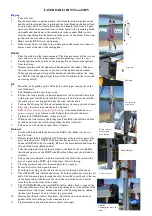
© 2004 Parallax, Inc. • Parallax USB Oscilloscope (#28014)
Version 1.0
Page 2
The
Understanding Signals Student Guide
For a detailed introduction to using the Parallax USB oscilloscope, we recommend the
Understanding
Signals Student Guide by Doug Pientak of Parallax Inc. Each activity includes a BASIC Stamp
®
-controlled
example circuit and code, directions for configuring the oscilloscope and placing the probes, and screen-
captures of the Parallax USB Software interface displaying the signal.
Understanding Signals is included
as a pdf on the Parallax CD under Documentation
→
Educational Curriculum
→
Understanding Signals
v1.0. You may purchase a printed copy (part #70009) or download the latest version from
www.parallax.com. (
Understanding Signals v1.0 was written when this oscilloscope was sold under the
name OPTAscope, but all the experiments in the text are valid for the Parallax USB Oscilloscope.)
Specifications:
•
2 Channels – view 2 signals at once
•
1 million samples per second maximum sample rate with one channel
•
500, 000 samples per second sample rate with 2 channels
•
View sine waves up to 60 kHz
•
View square waves up to 100 kHz
•
4 FFT functions: Black-Harris, Hamming, Rectangular, Hanning
•
20 Vpp maximum input for channel 1 and channel 2
•
200 kHz bandwidth
•
8-Bit vertical resolution
•
External trigger source: TTL rising edge, 5 V TTL maximum input
•
Trigger on rising or falling edge at any voltage
•
Variable trigger voltage on channels 1 and 2
•
Horizontal trigger position settings at 10%, 50%, and 90%.
•
Auto and normal trigger modes
•
Vertical, horizontal, and paired cursor functions
•
Zoom feature with active cursors
•
Built-in screen-capture bitmap function
•
1X probes included
•
USB 1.1 for data and power supply – no other power supply needed.
•
Size: 5’’ x 2.25” x 1.5” (excluding cable and probes)
•
Weight: 8 ounces
System Requirements
Minimum** configuration:
•
Windows
®
98 or higher operating system*
•
Pentium
®
233 MHz processor
•
32 MB of RAM
•
At least 15 MB of free disk space
•
Graphics card able to display an 800 X 600 resolution at 16-bit color depth.
•
HTML Viewer
•
Mouse or similar pointing device
Recommended** configuration:
•
Windows XP
•
Pentium II 450 MHz processor
•
64 MB of RAM
•
20 MB free disk space
•
Graphics card able to display a 1024 X 798 or higher resolution at 32-bit color depth.
•
HTML Viewer
•
Mouse or similar pointing device
*Windows 95 and NT are not supported, Windows XP is recommended.
** Performance is based on CPU speed.






















